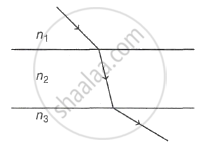Advertisements
Advertisements
Question
A concave mirror of curvature 40 cm, used for shaving purposes produces image of double size as that of the object. Object distance must be ______.
Options
10 cm only
20 cm only
30 cm only
10 cm or 30 cm
Solution
A concave mirror of curvature 40 cm, used for shaving purposes produces image of double size as that of the object. Object distance must be 10 cm or 30 cm.
Explanation:
The radius of curvature (R) of the concave mirror is 40 cm
The focal length (f) is given by:
`f = R/2 = 40/2 = 20` cm
The image is double the size of the object (m = −2m = −2m= −2) since concave mirrors produce inverted magnified images for real images.
The magnification m is related to object distance (u) and image distance (v) by:
`m = (-v)/u`
For magnification m = −2
`-2 = (-v)/u`
`-2 = (-v)/u or v = 2u`
Substitute f = 20 and v = 2u
`1/20 = 1/(2u) + 1/u`
`1/20 = (1 + 2)/(2u)`
= `3/(2u)`
u = `(3 xx 20)/2`
30 cm
Now, consider magnification of +2 (virtual image for shaving purpose): For virtual, upright image, m = 2, so;
`2 = (-v)/u ⇒ v = -2u`
Substituting v = −2u in the mirror formula:
`1/20 1/(-2u) + 1/u`
`1/20 =( -1 + 2)/(2u)`
= `1/(2u)`
u = 10 cm
Hence possible u = 10 or 30 cm
APPEARS IN
RELATED QUESTIONS
Answer the following question.
As per recent development, what is the nature of light? Wave optics and particle nature of light are used to explain which phenomena of light respectively?
Solve Numerical example.
A monochromatic ray of light strike the water (n = 4/3) surface in a cylindrical vessel at angle of incidence 53°. Depth of water is 36 cm. After striking the water surface, how long will the light take to reach the bottom of the vessel? [Angles of the most popular Pythagorean triangle of sides in the ratio 3:4:5 are nearly 37°, 53°, and 90°]
Distinguish between action spectrum and absorption spectrum.
Answer the following question.
What is the advantage of having more than one pigment molecule in a photocenter?
Light of wavelength 5000 A.U. falls on a plane reflecting surface. The frequency of reflected light is ______
In Young’s double-slit experiment, if there is no initial phase difference between the light from the two slits, a point on the screen corresponds to the 5th minimum. What is the path difference?
Which of the following is not a property of light?
A ray of light is incident at an angle ion one face of prism of small angle A and emerges normally from the other surface. µ is the refractive index of the material of the prism. The angle of incidence is _____________.
A parallel beam of fast-moving electrons is incident perpendicular on a narrow slit. The distance between slit and screen is large. If the speed of the incident electrons is increased then which one of the following statements is correct?
In the biprism experiment, fringes are obtained using monochromatic light. The distance between the 5th bright band and 9th dark band on the same side of the central bright band, in terms of the fringe width 'X' is ______
When light enters glass from vacuum then the wavelength of light ______
The critical angle for light travelling from medium P to medium Q is 'θ'. The speed of light in medium P is 'v'. Then the speed of light in medium Q is ______.
In a compound microscope, let u0 and v0 be the object distance and image distance respectively. The objective of focal length f0 magnifies a tiny object into a real, inverted image. The linear magnification of the objective is ______.
A beam of light passes from medium 1 to medium 2 to medium 3 as shown in the diagram. What may be concluded about the three refractive indices n1, n2 and n3?

